On the Trail of a Phoenix – Nasi Ulam
Nasi Ulam, or pronounced as “nasik ulam” in Baba Malay is a classic Peranakan dish which has its roots in Southeast Asian cooking. Comprising of essentially a variety of chiffonaded herbs tossed in steamed fragrant rice, it is painstaking to prepare and thus usually served on “ari besair” during weddings, birthdays or other celebratory events.
As mentioned, the combination of eating rice alongside a bouquet of herbs is common amongst culinary cultures in our region. It is called “nasi ulam” by the Indonesian, Malay and Peranakan community here in Singapore, but further up north in Peninsula Malaysia, it is more known as “Nasi Kerabu“, characterised for the inclusion of “budu”, a type of fermented fish sauce. In southern Thailand, it is called “Khao Yam Pak Tai” (ข้าวยำปักษ์ใต้) while the Burmese version is called “Htamin Thoke” and the list runs on…
Owing to geographical differences, the availability and preferences for certain herbs and condiments give rise to noticeable diversity in the ingredients used in preparation of “herbal rice”. Even between communities coexisting within the same locality, nasi ulam may also call for different herbs. For example, the use of “ulam raja” is a popular herb used in the Malay preparation of “nasi ulam” while it is generally omitted in the Peranakan renditions. That said, the recipe for nasi ulam can also vary across families, each with their own idiosyncrasies and particular likings for the use of certain herbs or ingredients while omitting others, thus giving rise the somewhat customised “unique flavours” of nasi ulam prepared. As such, it is highly laughable to hear some folks, notably nyonya-baba purists proclaim that a good nasi ulam must include “this and that”, or boast to have a certain number of ingredients, each trying to outdo the other by the plethora of ingredients one can conjure to add into his/her rendition of nasi ulam for it to reign supremacy over others. To these folks, superficial sophistication stems from blind complexity, missing out entirely on the notion of “balance”, and a true appreciation that “less is sometimes actually more”…
It is said that when a bibik was looking for a prospective “anak dara” from a respectable family to become the wife of her son, she would request for the potential candiates to cook a small spread of “laok embok embok” comprising of a specific number of dishes to “test” the young ladies’ culinary capabilities. To many, the common dish to cook was “nasi lemak” while for some it was “nasi ulam“. If I were a “neo” in the yesteryears, I would have chosen the latter to be the challenge as this dish showcases a range of skills needed for one to work efficiently in a “dapor nyonya“, i.e. “tumbok” and “tumis” a basic rempah, the knifework behind all the cutting, slicing and chopping etc. A clever and discerning little nyonya would be quick to display her dexterity and skills to show her “potentials” of becoming a virtuous wife yet should not attempt to display her full prowess that might in turn undermine or even threaten the status of her “neo“, the current matriarch of the household. All the necessary skills to survive in a traditional Peranakan household in the past. Anyway, I’d digressed…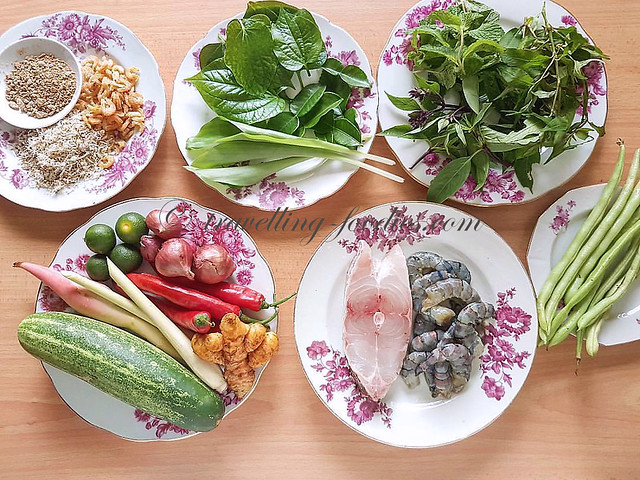
The true art in the preparation of “nasi ulam” lies not only in the choice of herbs and ingredients to use but more importantly the “mise en place“. Firstly, the selection of the leaves is important, making sure that every blade is fresh and free of blemishes. If a lighter and more refreshing taste is preferred, young and tender leaves or shoots can be chosen but if one should desires stronger and more robust flavours on the palate, more matured and fully grown leaves can be plucked. In any case the leaves should not look “old and tired” and of course brown or wilted ones are a big no no. Each herb must be “iris alus” i.e. sliced so finely so that the final dish would look very refined or in Baba Malay, “senonoh“. The leaves of some herbs should be stacked before slicing while others need to be rolled before chiffonading. While all leaves need to have their stems and stalks removed, “tougher fellas” like kaffir lime leaves aka “daon lemo purot” need to have their fibrous midrib veins pulled out before being sliced or it would affect the palate sensation in the end.
For my nasi ulam, the herbs and condiments which I commonly use are as follows,
| English Name | Malay – Indonesian Name | Baba Malay Name |
| Mint leaves | Daun pudina | Daon pudina |
| Thai Basil leaves | Daun selasih | Daon selasih |
| Lemon Basil leaves | Daun kemangi | Daon kemangi |
| Wild pepper leaves | Daun kaduk | Daon kadok |
| Turmeric leaves | Daun kunyit | Daon kunyit |
| Sand ginger leaves | Daun cekur / Daun Kencur | Daon cekor |
| Kaffir lime leaves | Daun limau purut | Daon lemo purot |
| Torch ginger bud | Bunga kantan | Bunga kantan |
| Long beans | Sayur kacang | Sayor kachang |
| Turmeric root | Kunyit hidup | Kunyit idop |
| Cucumber | Timun | Timun |
| Dried shrimp | Udang kering | Udang kering |
| Toasted grated coconut | Kerisik | Kerisik |
There are some other “special” and elusive herbs which are used in the old recipes to Peranakan version of nasi ulam like sayor buas buas but these are generally not easy to find. As such one should not fret in fear that the authenticity of a good nasi ulam is lost without these as the other herbs are more than enough to make up for it…
Apart from the herbal concoction, other vegetables are also used to lend texture and crunch. The common ones would be timun (cucumber), sayor kachang (long beans) or even kachang botol (winged beans). I prefer kachang pranchis (french beans) over snake beans as the former has a delightful crunch to it. While the cucumber are brunoised i.e cut into very small cubes, the beans are sliced into thin rings and panfried quickly to rid them of rawness. Winged beans however can be briefly blanched or simply eaten raw.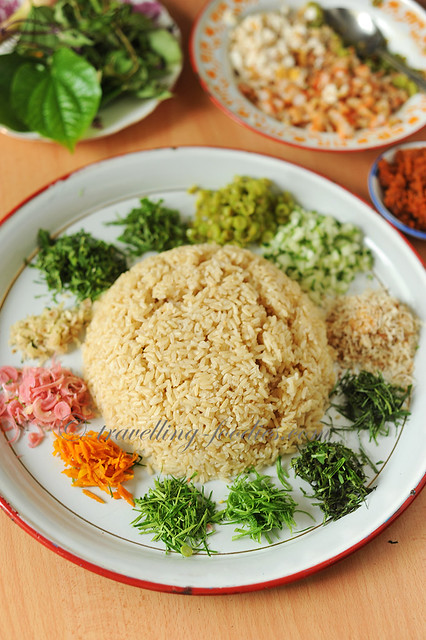
For a balanced and complete meal, some protein is usually incorporated into the Peranakan nasi ulam. It is usually seafood, i.e. fish and fresh prawns, as well as dried shrimp (udang kering) or even krill (udang grago kering). For fish, any meaty fish can be used. Wolf herring aka dorab (ikan parang) is preferred although other good options include red snapper (ikan merah) , garoupa (ikan kerapu), ikan selar, ikan cencaru or even seabass (ikan siakap) aka barramundi. The fish are panfried with a little oil and then flaked. Fresh prawns are either poached or lightly sauteed before being chopped into small chunks. Salted fish is also commonly added to nasi ulam to enhance the umami flavours but I’d omitted it in this rendition as I am eating my nasi ulam with aceir ikan asin homemade by my friend Poh Lin’s mum Nyonya Guek in Melaka. So so good…
For some folks, the rempah titek, udang kering and kerisik are kept separate but I like to prepare the rempah titek into a sambal tumis before adding dried shrimp floss to become sambal udang kering aka hae bee hiam and then tossed with part of the kerisik to become an enriched serondeng. This is done first and set aside to cool down before getting on with the remaining ingredients.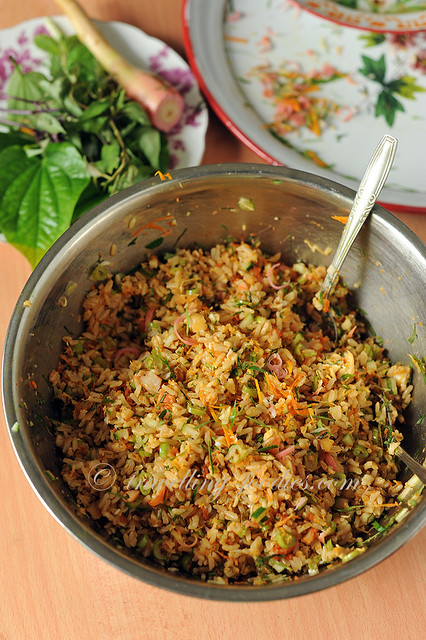
While the steamed rice is left to cool, the tedious mise en place of all the other ingredients begins. It is important for all the ingredients to be at room temperature before tossing everything into a mixture as heat can cause the herbs to turn black or taste bitter. After that, it is just a case of getting everything into a mixing bowl and toss away!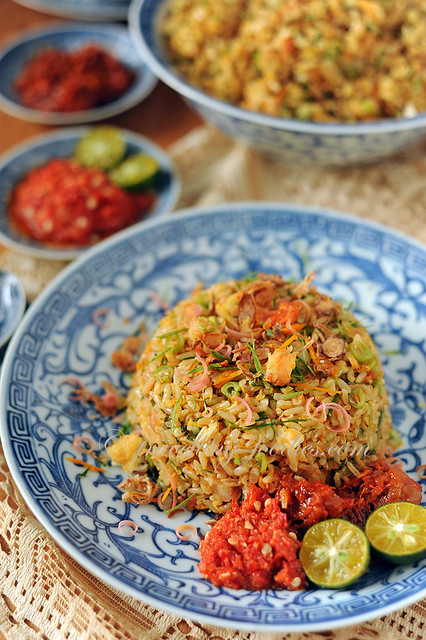
Nasi Ulam Nyonya (serves 4-5)
Rice Ingredients
2 cups of rice, rinsed
2 1/4 cups water
1/2 tsp salt
2-3 blades of pandan leaves, tied into a bundle
Place the rinsed rice into a pot and pour water over to completely submerged.
Let the grains steep for 20-30 min.
Add salt and stir well.
Place pandan leaf bundle over the rice.
Bring to a boil before lowering the flame and let it continue to cook under very very low heat until the grains are fully cooked and significantly dry.
Set aside to cool down before using.
Ulam Ingredients
1-2 stalks torch ginger flower bud
15-20 Vietnamese mint leaves
15 lemon basil leaves
10 Thai basil leaves
10 young wild pepper leaves
10 mint leaves
3 sand ginger leaves
1 young turmeric leaf
5-8 kaffir lime leaves
6 stalks long beans or french beans
2 stalks lemongrass, lower white portion only
1 medium cucumber, quartered lengthwise and deseeded
1 thumb-knob of fresh turmeric root, peeled
Remove the stalks of all the ulam leaves, as well as the midrib of kaffir lime leaves.
Thinly slice all the leaves and peeled turmeric root into very narrow strips.
Slice the torch ginger bud, french beans and lemon grass into very very thin rings.
Cut the cucumber into very small cubes, the size of cooked rice grains
Rempah Titek/Sambal Tumis ingredients
10-12 shallots, peeled
5 red chilies, stalks removed
5 candlenuts, rinsed briefly
1 tbsp toasted belacan powder
3-4 heap tbsp kerisik, i.e. toasted grated coconut
50g dried shrimp, pound or blend into floss
salt and sugar to taste
oil for cooking
Pound or blend the shallots, chilies and candlenuts to form a coarse paste
To a heated wok, add cooking oil and fry the rempah titek paste with sambal belacan powder until fragrant and oil begins to separate.
Add dried shrimp floss and saute until aromatic to form sambal udang kering.
Adjust flavours with salt and a bit of sugar
Add kerisik and mix well to homogenise.
Drain off excess oil and set aside to cool down.
Other Ingredients
1 piece of meaty fresh fish, preferably wolf herring (dorab), red snapper, selar etc, appro. 200-250g
10-12 fresh prawns, peeled and deveined
A small piece of salted fish, preferably threadfin (ikan kurau) cut into small pieces, optional
6-8 red chilies (mixture of large red and bird’s eye chili for more heat)
Juice from 6-8 calamansi lime
1 tsp toasted belacan powder
1 tbsp oil for frying fish and shrimp
salt and sugar to taste
Fried shallots & fried garlic slices for garnish
To a heated wok, pan fry fish until both sides turn golden brown and the insides are cooked. Remove and set aside to cool down. Remove skin and flake into small pieces.
To the same wok, lightly pan fry the fresh prawns until they are just cooked. Remove and set aside to cool down. Cut into small cubes
If using, cut the salted fish into small cubes and lightly saute until slightly brown and crisp. Remove and set aside to cool down.
To the same wok, lightly saute the sliced french beans from “ulam ingredients” very briefly just to remove the “rawness”. Remove and set aside to cool down.
To make sambal belacan, pound or blend the red chilies with toasted belacan powder. Shredded kaffir lime leaves may also be added for extra zing. Adjust with a bit of salt. Add calamansi lime juice and mix well to incorporate.
To assemble, first ensure that all the ingredients are at room temperature.
To a large mixing bowl, add cooked rice followed by the sambal tumis. Fluff the rice with two forks or by hand until every grain is evenly coated and coloured by the sambal tumis.
Add in all the sliced ulam ingredients as well as cooked ingredients i.e. shrimp, fish, french beans and toss to mix everything together uniformly.
Dish up to serve and garnish with more sliced ulam ingredients, kerisik, fried shallot or garlic slices.
Serve alongside with sambal belacan, and for my case, Nyonya Guek’s aceir ikan asin.
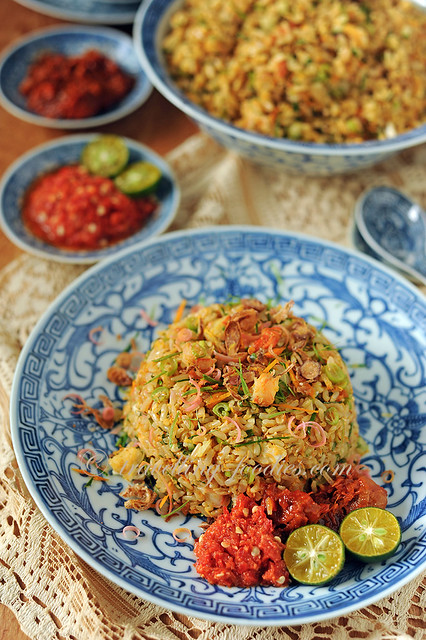
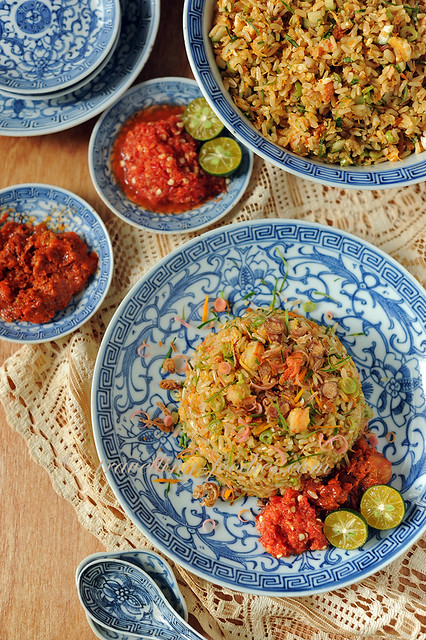

Pingback: On the Trail of the Phoenix – Jiu Hu Char… A Revisit | travellingfoodies